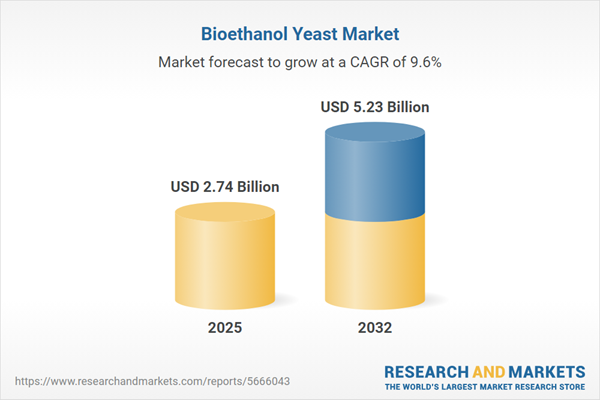Speak directly to the analyst to clarify any post sales queries you may have.
The bioethanol yeast market is providing senior decision-makers with actionable opportunities to drive operational efficiency, enhance supply chain resilience, and align enterprise strategies with emerging sustainability priorities. Current trends indicate that organizations are leveraging yeast technology innovations to maintain competitiveness and regulatory compliance within increasingly complex market environments.
Market Snapshot: Bioethanol Yeast Market Gaining Momentum Amid Decarbonization
Driven by decarbonization efforts and the global shift toward renewable energy, the bioethanol yeast market is entering a phase of sustained innovation. The total market size stands at USD X, accompanied by a projected CAGR of X% from 2023 to 2030. Modern yeast technologies are enabling organizations to boost production efficiency, reduce operational challenges, and strengthen supply chain adaptability. Notably, the influence of yeast solutions now extends past traditional biofuel manufacturing, with adoption growing in food, nutrition, and other industries. Industry leaders are building competitive advantages by accelerating technology integration and increasing agility, supporting broader participation in the energy transition landscape.
Scope & Segmentation of the Bioethanol Yeast Market
Comprehensive segmentation empowers executive teams to tailor investments and strategies for maximum regulatory, operational, and technological alignment within the sector. This analysis encompasses several core segments:
- Product Types: Includes active yeast for fermentation, dried yeast for extended shelf-life, fresh yeast for specialized production protocols, inactive and feed yeast for supporting industrial needs, and nutritional yeast spearheading advancements within food sectors.
- Formulation Types: Covers both liquid and solid yeast, giving manufacturers flexibility in procurement strategy and logistical integration for optimized operations.
- Technologies: Encompasses established and advanced fermentation techniques, batch and continuous processing, genetic improvements, and hybrid approaches designed for scalability and adaptability amid dynamic market needs.
- End-User Industries: Incorporates entities in fuel production, food and beverage, nutraceuticals, and pharmaceuticals, each benefiting from yeast technology refined for specific operational and compliance requirements.
- Applications: Supports biofuel production, sustainable bioproduct innovation, ecological solutions, and the implementation of circular economy practices throughout multiple sectors.
- Regions Covered: North America, Latin America, Europe, Middle East, Africa, and Asia-Pacific, each characterized by unique regulations, infrastructure, and supply chain nuances shaping local market approaches.
- Leading Companies Profiled: Profiles Novozymes A/S, Lesaffre Group, AB Mauri, Chr. Hansen Holding A/S, Angel Yeast Co., Ltd., Lallemand Inc., DSM N.V., Cargill, Incorporated, Associated British Foods plc, Kerry Group plc, BASF SE, DuPont de Nemours, Inc., Archer Daniels Midland Company, Biorigin, Pak Group, Oriental Yeast Co., Ltd., Alltech, Inc., Synergy Flavors, and Kemin Industries, Inc., focusing on technology progress and value chain development.
Key Takeaways for Senior Decision-Makers
- Innovation in bioethanol yeast enables organizations to diversify feedstock sourcing, reducing exposure to variability in pricing and supply quality.
- Automated fermentation and advanced processing systems help sustain output uniformity while meeting new regulatory or operational standards.
- Strategic supply chain partnerships speed introduction of enhanced yeast strains and reinforce business continuity during regulatory shifts.
- Expansion into markets like energy storage, nutrition, and eco-friendly materials opens new revenue channels while balancing risk across core business areas.
- Access to agricultural byproducts and responsive R&D efforts allow for rapid yeast product innovation as markets and regulations evolve.
- Process optimization and consultative services give organizations an edge in addressing shifting end-user demands and maintaining operational excellence.
Tariff Impact: Navigating United States Trade Measures
Recent tariff measures on yeast and essential feedstock imports in the United States are prompting companies to reassess production and sourcing models. Investment in localized R&D capacity and domestic manufacturing is increasing in response to these challenges, promoting greater long-term supply stability. For firms with heavier import reliance, improved supplier collaboration and technology upgrades are helping to mitigate disruption risks. As a result, the market is moving toward more decentralized and flexible production networks, enhancing responsiveness to evolving policies and customer requirements.
Methodology & Data Sources
This report synthesizes insights from executive interviews, expert commentary, and direct input from R&D teams. Analysis is grounded in technical documentation, patent research, and compliance review, delivering insights relevant to senior management decision-making.
Why This Report Matters for Decision-Makers
- Enables data-driven capital allocation, helping executive teams prioritize technology investments and design targeted regional strategies within complex market dynamics.
- Facilitates proactive alignment of operations to emerging regulatory requirements, reinforcing the organization’s flexibility and long-term success.
- Prepares leadership to establish strategic partnerships and scale their response to future regulatory and end-user market changes.
Conclusion
Effective bioethanol yeast market intelligence empowers executives to drive innovation, foster cross-sector collaboration, and achieve lasting growth as technological and regulatory environments evolve.
Additional Product Information:
- Purchase of this report includes 1 year online access with quarterly updates.
- This report can be updated on request. Please contact our Customer Experience team using the Ask a Question widget on our website.
Table of Contents
3. Executive Summary
4. Market Overview
7. Cumulative Impact of Artificial Intelligence 2025
Companies Mentioned
The companies profiled in this Bioethanol Yeast market report include:- Novozymes A/S
- Lesaffre Group
- AB Mauri
- Chr. Hansen Holding A/S
- Angel Yeast Co., Ltd.
- Lallemand Inc.
- DSM N.V.
- Cargill, Incorporated
- Associated British Foods plc
- Kerry Group plc
- BASF SE
- DuPont de Nemours, Inc.
- Archer Daniels Midland Company
- Biorigin
- Pak Group
- Oriental Yeast Co., Ltd.
- Alltech, Inc.
- Synergy Flavors
- Kemin Industries, Inc.
Table Information
| Report Attribute | Details |
|---|---|
| No. of Pages | 192 |
| Published | October 2025 |
| Forecast Period | 2025 - 2032 |
| Estimated Market Value ( USD | $ 2.74 Billion |
| Forecasted Market Value ( USD | $ 5.23 Billion |
| Compound Annual Growth Rate | 9.5% |
| Regions Covered | Global |
| No. of Companies Mentioned | 20 |









